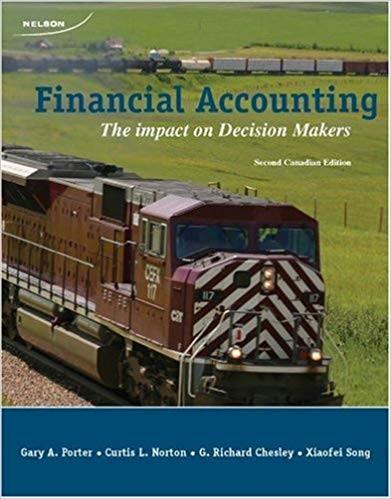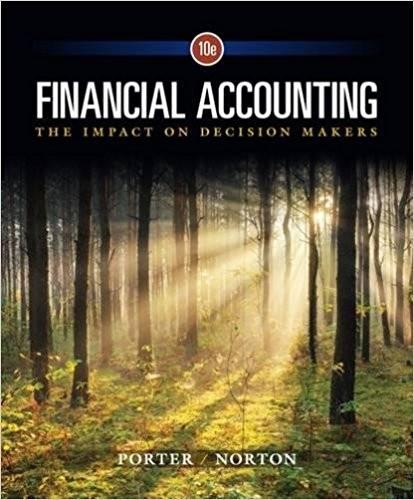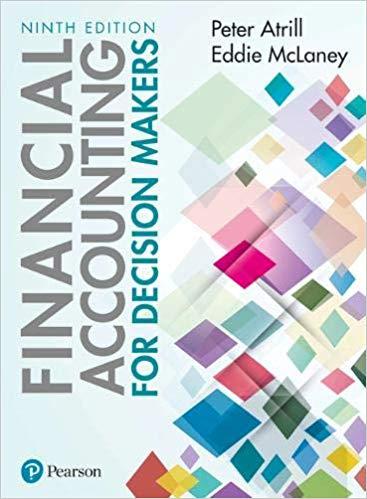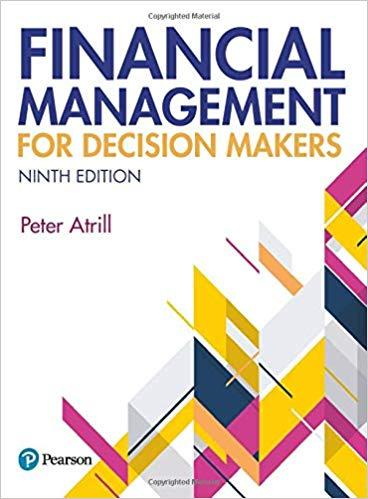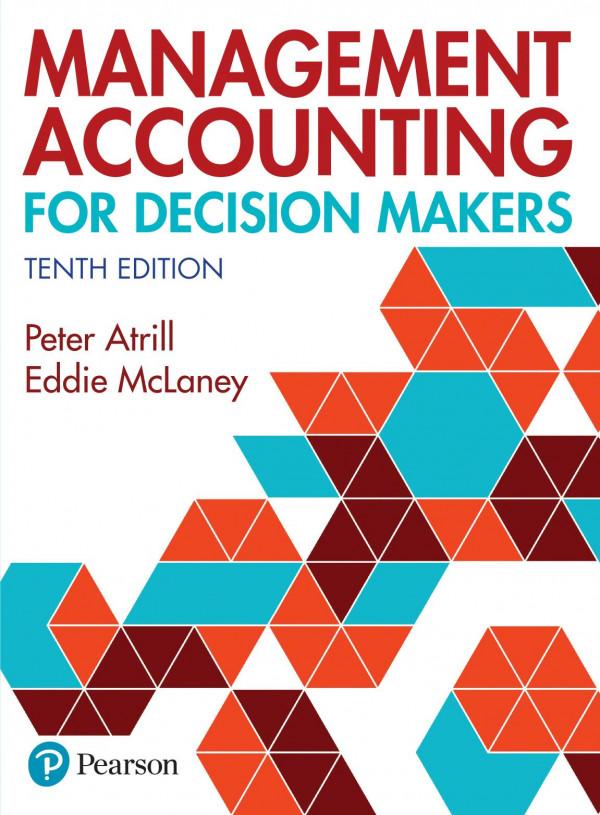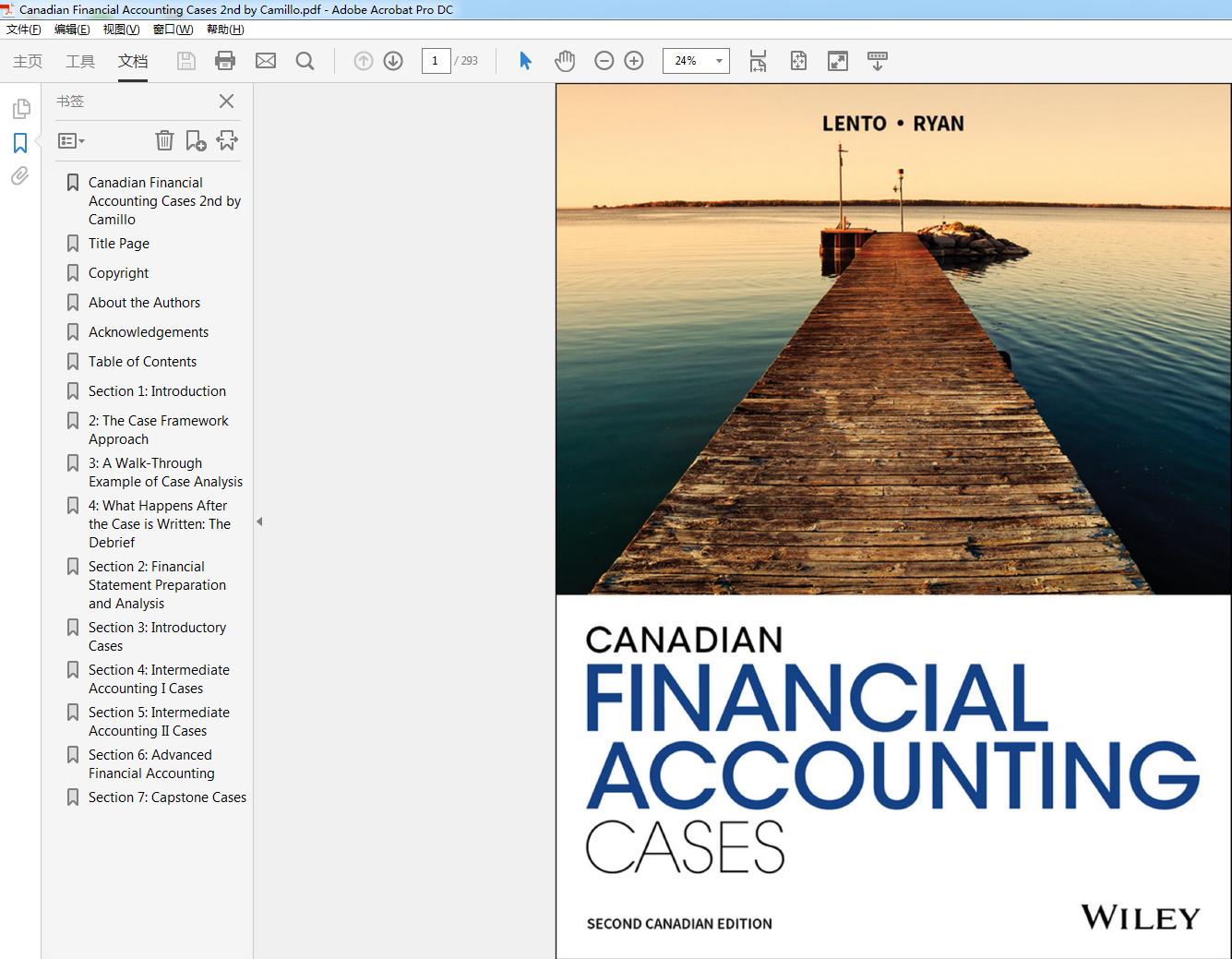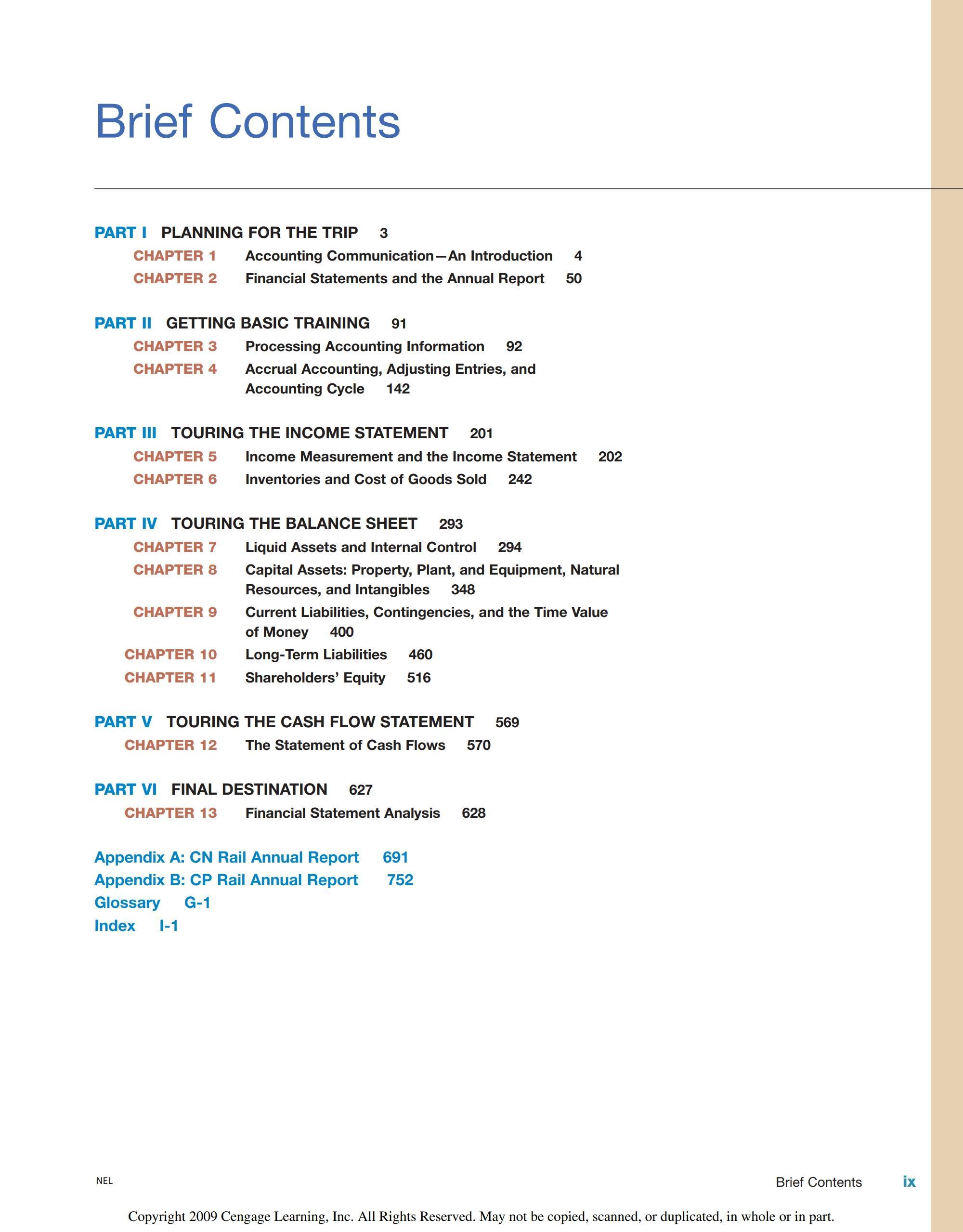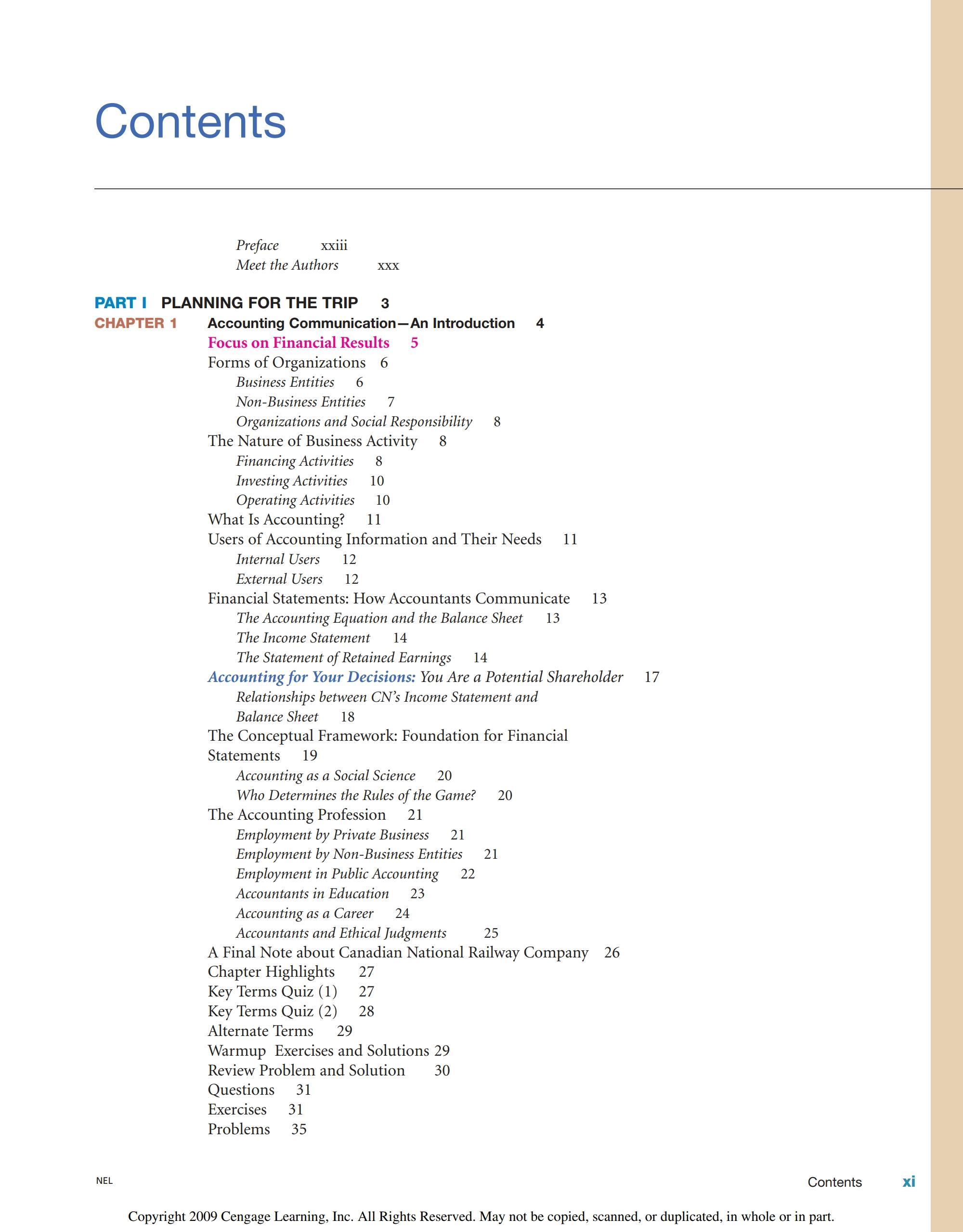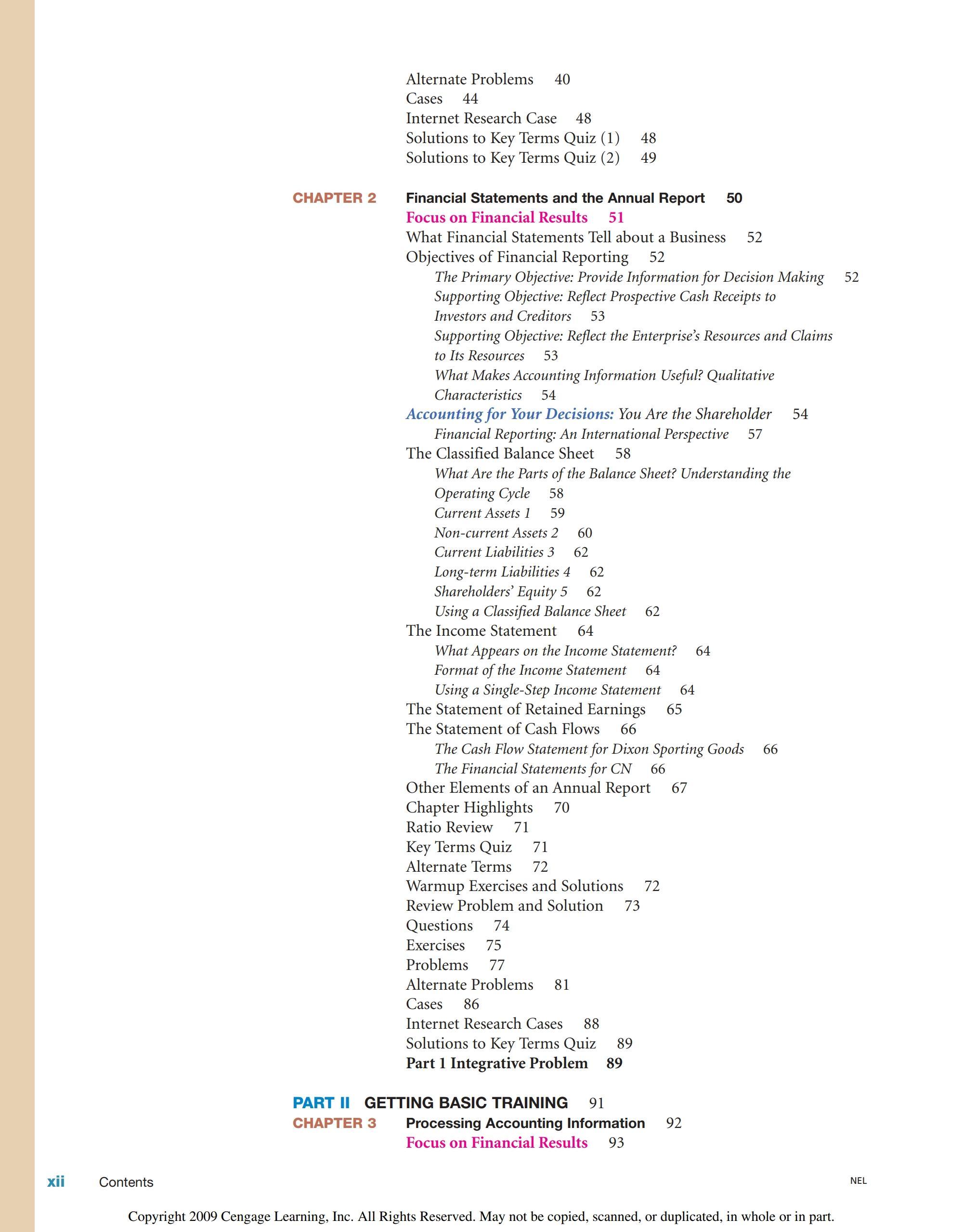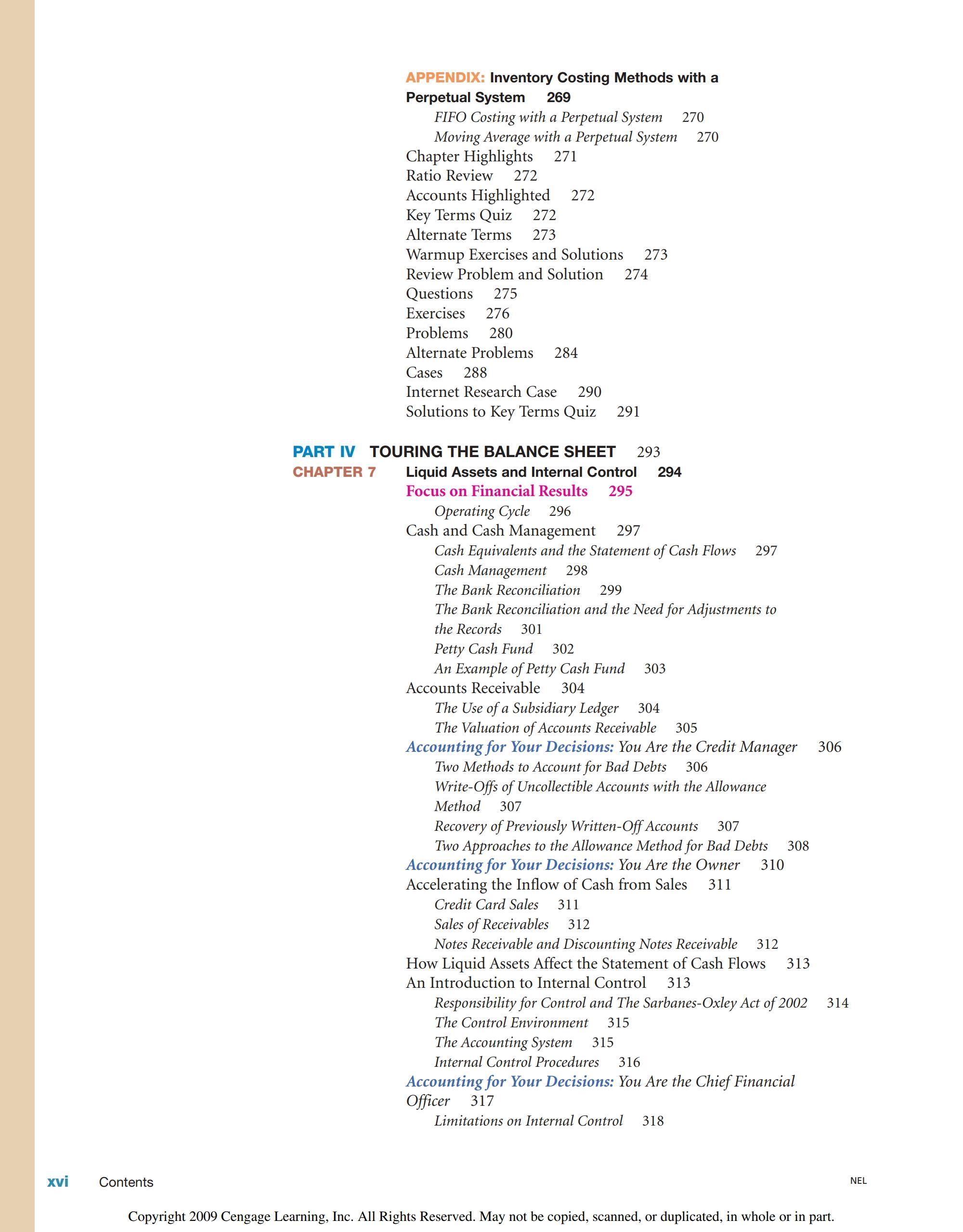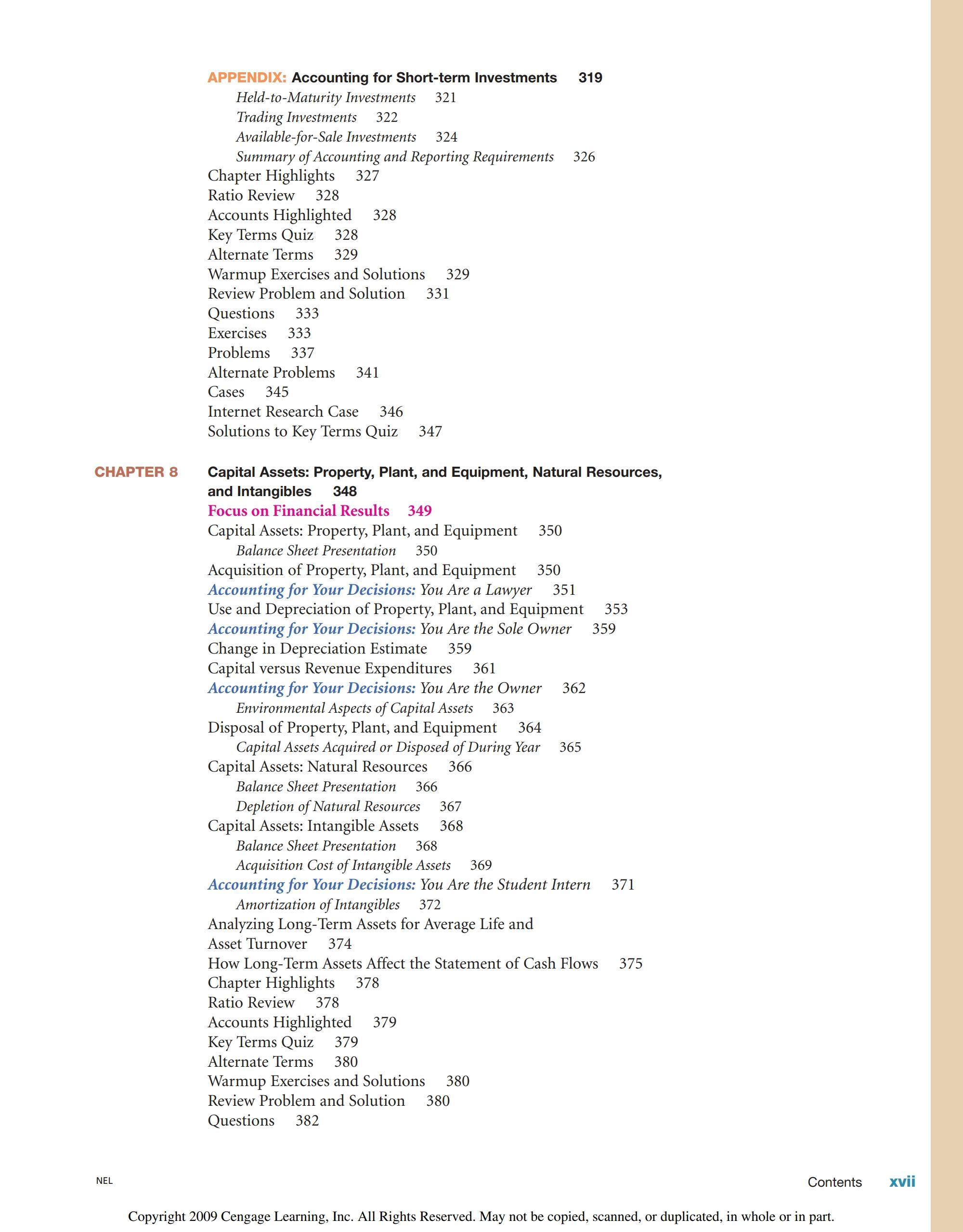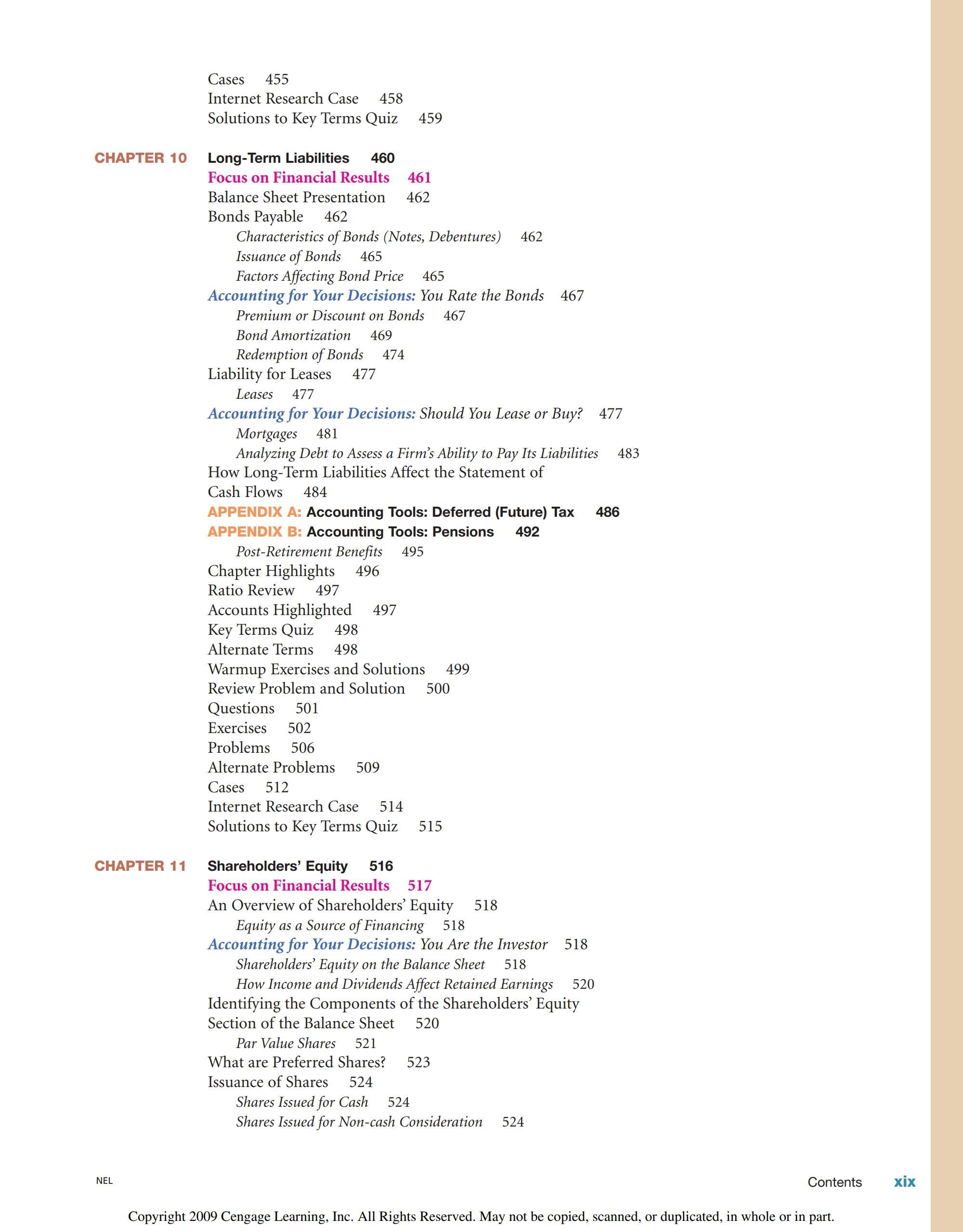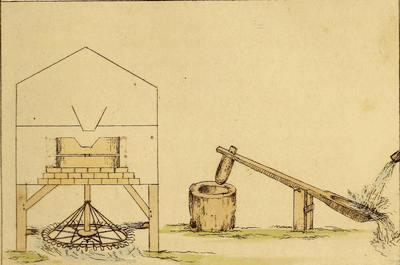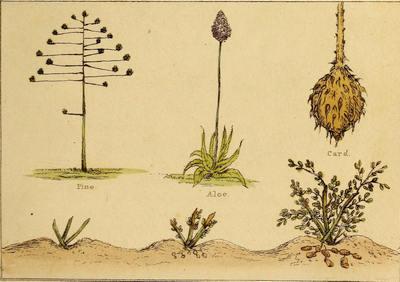Balance of Preparer Perspective and User Focus. Discover the Best of Both with Porter/Norton/ChesleyI Song-Bau
Id!
nyone who works out regul arly appreciates the need to maintain a healthy balance between cardiovascular/aerobic training and muscular/strength training. Likewise, the study of accounting requires a balance between an understanding of the preparation of financial statements and the use of those statements in decision making.
A STUDENT finishing a financial accounting course needs to be ab l e to read and understand an annual report. At the same time, he or she needs a solid understanding of the preparation of financial statements from transactions. This is why, from the very first edition, we have pursued '' a balance between a Preparer Perspective and a User Focus. From our experience, students need to understand both how transact i ons are recorded and statements are prepared and also how accounting information is used and why it is important for financial decision making.
WE INVITE you to discover the best of both with Financial Accounting: The Impact on Decision Makers, Second Canadian Editi on.
PART I PLANNING FOR THE TRIP 3
CHAPTER 1
CHAPTER 2 Accounting Communication-An Introduction 4 Financial Statements and the Annual Report 50
PART II GETTING BASIC TRAINING 91
CHAPTER 3
CHAPTER 4 Processing Accounting Information 92
Accrual Accounting, Adjusting Entries, and Accounting Cycle 142
PART Ill TOURING THE INCOME STATEMENT 201
CHAPTER 5
CHAPTER 6
Income Measurement and the Income Statement 202 Inventories and Cost of Goods Sold 242
PART IV TOURING THE BALANCE SHEET 293
CHAPTER 7
CHAPTER 8
CHAPTER 9
CHAPTER 10
CHAPTER 11
Liquid Assets and Internal Control 294
Capital Assets: Property, Plant, and Equipment, Natural Resources, and Intangibles 348
Current Liabilities, Contingencies, and the Time Value of Money 400
Long-Term Liabilities 460
Shareholders' Equity 516
PART V TOURING THE CASH FLOW STATEMENT 569
CHAPTER 12 The Statement of Cash Flows 570
PART VI FINAL DESTINATION 627
CHAPTER 13 Financial Statement Analysis 628
Appendix A: CN Rail Annual Report 691
Appendix B: CP Rail Annual Report 752
Glossary G-1
Index 1-1
CHAPTER 2
Alternate Problems 40
Cases 44
Internet Research Case 48
Solutions to Key Terms Quiz ( 1) 48
Solutions to Key Terms Quiz (2) 49
Financial Statements and the Annual Report 50
Focus on Financial Results 51
What Financial Statements Tell about a Business 52 Objectives of Fin an cial Reporting 52
The Primary Objective: Provide I nformation for Decision Making 52
Supporting Objective: Reflect Prospective Cash Receipts to Investors and Creditors 53
Supporting Objective: Reflect the Enterprise's Resources and Claims to Its Resources 53
What Makes Accounting Information Useful? Qualitative Characteristics 54
Accounting for Your Decisions: You Are the Shareho lde r 54
Financial Reporting: An International Perspective 57
The Class ified Balance Sheet 58
What Are the Parts of the Balance Sheet? Understanding the Operating Cycle 58
Current Assets 1 59
Non-current Assets 2 60
Current Liabilities 3 62
Long-term Liabilities 4 62
Shareholders' Equity 5 62
Using a Classified Balance Sheet 62
The Income Statement 64
What Appears on the Income Statement? 64 Format of the In come Statement 64 Using a Single-Step Income Statement 64
The Statement of Retained Earnings 65
The Statement of Cash Flows 66
The Cash Flow Statement for Dixon Sporting Goods 66
The Financial Statements for CN 66
Other Elements of an Annual Report 67
Chapte r Highlights 70
Ratio Review 71
Key Terms Quiz 7 1
Alternate Terms 72
Warmup Exercises and Solutions 72
Review Problem and Solution 73 Questions 74
Exercises 75 Problems 77
Alternate Problems 81
Cas es 86
Internet Research Cases 88
Solutions to Key Terms Quiz 89
Part I Integrative Problem 89
PART II GETTING BASIC TRAINING 91
CHAPTER 3 Processing Accounting Information 92 Focus on Financial Results 93
CHAPTER 4
Economic Events: The Basis for Recording Transactions 94
External and Internal Events 94
The Role of Source Documents in Recording Transactions 94
Analyzing the Effects of Transactions on the Accounting Equation 95
Transactions of Glengarry Health Club 95
Balance Sheet and Income Statement for the Health Club 100
The Double- Entry System 102
The Account 102
Chart of Accounts 102
The T Account 103
Debits and Credits 104
Accounting for Your Decisions: You Are a Student 105
Debits and Credits for Revenues, Expenses, and Dividends 105
Summary of the Rules for Increasing and Decreasing Accounts 106
Normal Account Balances 106
Debits Aren't Bad, and Credits Aren't Good 106
Debits and Credits Applied to Transactions 107
The Journal 107
Recording Transactions for Glengarry Health Club 107
The Ledger and Trial Balance 110
Accounting for Your Decisions: You Are the Manager 114
The Trial Balance 114
Accounting for Your Decisions: You Are the Shareholder 115
Chapter Highlights 116 Accounts Highlighted 117
Key Terms Quiz 117
Alternate Terms 118
Warmup Exercises and Solutions 118
Review Problem and Solution 119
Questions 121
Exercises 121 Problems 126
Alternate Problems 132 Cases 137
Solutions to Key Terms Quiz 141
Accrual Accounting, Adjusting Entries, and Accounting Cycle 142
Focus on Financial Results 143
Recognition and Measurement in Financial Statements 144
Recognition 144
Measurement 144
Summary of Recognition and Measurement in Financial Statements 146
The Accrual Basis of Accounting 146
Comparing the Cash and Accrual Bases of Accounting 146 What the Income Statement and the Statement of Cash Flows Reveal 14 7
Accrual Accounting and Time Periods 149
Accrual Accounting and Adjusting Entries 149
Types of Adjusting Entries 149
Accounting for Your Decisions: You Are the Store Manager 150
Accounting for Your Decisions: You Are the Banker 153
Terminology 156
Summary of Adjusting Entries 1 57
Adjusting Entries for Glengarry Health Club 157
T h e Accoun ti n g Cyc le 161
Closing the Accounts of Glengarry Health Club 162
I nterim Financial Statements 164
APPENDIX: Work Sheets 164
Step 1: The Unadjusted Trial Balance Columns 165
Step 2: The Adjusting Entries Columns 165
Step 3: The Adjusted Trial Balance Columns 165
Step 4 : The I ncome Statement Columns 165
Step 5: The Balance Sheet Columns 166
C h ap t er Hi g hli g h ts 168
Acc o u nts Hi g hli g hted 168
Key Term s Q ui z 169
Alte rn ate Term s 169
War mup Exerc ises a nd Solu tio n s 170
Revi ew Pr ob lem an d Solu ti on 17 1
App endix Review Prob lem and So l uti o n 173
Q u est io n s 17 5
Exe r cises 17 5
P r ob l ems 182
Al t ern ate P r ob l em s 189
Cas es 195
So l uti o n s to Key Ter m s Qu i z 197
Part II Int egrative Problem 198
PART Ill TOURING THE INCOME STATEMENT 20
CHAPTER 5
1
Income Measurement and the Income Statement 202
Focus on Financial Results 203
The Reve n ue Reco n g n itio n P rin ci ple 204
Applications of the Revenue Recognition Principle 204
Accounting for Your Decisions: You Are the Marketing Manager 205
Accounting for Your Decisions: You Are the Shareholder 206
The Mat chin g P rin ci p l e a n d Expe n se Recog ni tion 207
Costs and Expenses 207
Direct and Indirect Matching 208
The Fo rm at and Co n t e nt of t h e
In co m e Stat em en t 209
Single-Step versus Multiple-Step Format for the Income Statement 209
Net Sales 210
Sales Returns and Allowances 2 11
Trade Discounts and Quantity Discounts 2 12
Credit Terms and Sales Discounts 2 13
The Cost of Goods Sold and Gross Profit 2 14
The Cost of Goods Sold Model 214
Operating Expenses and Income from Operations 2 16
Other Revenues and Expenses and Income before Income Taxes 2 17
Income Tax Expenses and Net I ncome 217
Ad dition al I tems in t h e In co m e State m en t 2 18
Discontinued Operations 2 1 8
Extraordinary Items 2 18
Unusual or I nfrequent I tems 219
Estimating the Effect of Income Taxes 220
Comprehensive Income 220
Pro Forma Earnings 221
How Sales Affect the Cash Flow Statement 222
APPENDIX: Sales Taxes 223
Chapter Highlights 224
Ratio Review 225
Accounts Highlighted 225
Key Terms Quiz 225
Alternate Terms 226
Warmup Exercises and Solutions 226
Review Problem and Solutions 227
Questions 228
Exercises 228
Problems 230
Alternate Problems 234
Cases 238
Internet Research Case 241
Solutions to Key Terms Quiz 241
Inventories and Cost of Goods Sold 242
Focus on Financial Results 243
Inventory Systems 244
The Nature of Inventories 244
Periodic versus Perpetual System 244
Journal Entries of the Two Systems 245
Accounting for Your Decisions: You Are the Enterprenor 24 7
Cost of Goods Purchased 24 7
Accounting for Your Decisions: You Are the President 248
Shipping Terms and Transportation Costs 249
Accounting for Your Decisions: You are the Manager 251
Inventory Costing Methods with a Periodic System 251
Specific Identification Method 253
Weighted Average Cost Method 254
First-In, First-Out Method ( FIFO ) 254
Last-In, First-Out Method (LIFO ) 255
Accounting for Your Decisions: You Are the Controller 255
The Effects of Inventory Costing Method 256
Costing Methods, Gross Profit, Income Tax Expense, and Net Income 256
Accounting for Your Decisions: You Are a Student 257
Changing Inventory Methods 257
Inventory Valuation in Other Countries 257
Additional Topics on Inventory: Errors, Lower of Cost or Market, and Estimation 258
Inventory Errors 258
Valuing Inventory at Lower of Cost or Market 261
Why Lower of Cost or Market Is Used 261
Conservatism Is the Basis for the Lower-of-Cost-or-
Market Rule 262
Accounting for Your Decisions 263
Methods for Estimating Inventory Value 263
How Inventories Affect The Statement of Cash Flows 267
APPENDIX: Inventory Costing Methods with a Perpetual System 269
FIFO Costing with a Perpetual System 270
Moving Average with a Perpetual System 270
Chapter Highlights 271
Ratio Review 272
Accounts Highlighted 2 72
Key Terms Quiz 2 72
Alternate Terms 273
Warmup Exercises and Solutions 273
Review Problem and Solution 27 4
Questions 2 7 5
Exercises 2 7 6
Problems 280
Alternate Problems 284
Cases 288
Internet Research Case 290
Solutions to Key Terms Quiz 291
PART IV TOURING THE BALANCE SHEET 293
CHAPTER 7
Liquid Assets and Internal Control 294
Focus on Financial Results 295
Operating Cycle 296
Cash and Cash Management 297
Cash Equivalents and the Statement of Cash Flows 297
Cash Management 298
The Bank Reconciliation 299
The Bank Reconciliation and the Need for Adjustments to the Records 301
Petty Cash Fund 302
An Example of Petty Cash Fund 303
Accounts Receivable 304
The Use of a Subsidiary Ledger 304
The Valuation of Accounts Receivable 305
Accounting for Your Decisions: You Are the Credit Manager 306
Two Methods to Account for Bad Debts 306
Write-Offs of Uncollectible Accounts with the Allowance Method 307
Recovery of Previously Written-Off Accounts 307
Two Approaches to the Allowance Method for Bad Debts 308
Accounting for Your Decisions: You Are the Owner 310
Accelerating the Inflow of Cash from Sales 311
Credit Card Sales 311
Sales of Receivables 312
Notes Receivable and Discounting Notes Receivable 312
How Liquid Assets Affect the Statement of Cash Flows 313
An Introduction to Internal Control 313
Responsibility for Control and The Sarbanes-Oxley Act of 2002 314
The Control Environment 315
The Accounting System 315
Internal Control Procedures 316
Accounting for Your Decisions: You Are the Chief Financial Officer 317
Limitations on Internal Control 318
Held-to-Maturity Investments 321
Trading Investments 322
Available-for-Sale Investments 324
Summary of Accounting and Reporting Requirements 326
Chapter Highlights 327
Ratio Review 328
Accounts Highlighted 328
Key Terms Quiz 328
Alternate Terms 329
Warmup Exercises and Solutions 329
Review Problem and Solution 331
Questions 333
Exercises 3 33
Problems 337
Alternate Problems 341
Cases 345
Internet Research Case 346
Solutions to Key Terms Quiz 347
Capital Assets: Property, Plant, and Equipment, Natural Resources, and Intangibles 348
Focus on Financial Results 349
Capital Assets: Property, Plant, and Equipment 350
Balance Sheet Presentation 350
Acquisition of Property, Plant, and Equipment 350
Accounting for Your Decisions: You Are a Lawyer 351
Use and Depreciation of Property, Plant, and Equipment
Accounting for Your Decisions: You Are the Sole Owner
Change in Depreciation Estimate 359
Capital versus Revenue Expenditures 361
Accounting for Your Decisions: You Are the Owner 362
Environmental Aspects of Capital Assets 363
Disposal of Property, Plant, and Equipment 364
Capital Assets Acquired or Disposed of During Year 365
Capital Assets: Natural Resources 366
Balance Sheet Presentation 366
Depletion of Natural Resources
Capital Assets: Intangible Assets
Balance Sheet Presentation 368 367 368
Acquisition Cost of Intangible Assets 369 353 359
Accounting for Your Decisions: You Are the Student Intern 371
Amortization of Intangibles 372
Analyzing Long-Term Assets for Average Life and Asset Turnover 374
How Long-Term Assets Affect the Statement of Cash Flows 375
Chapter Highlights 378
Ratio Review 378
Accounts Highlighted 379
Key Terms Quiz 379
Alternate Terms 380
Warmup Exercises and Solutions 380
Review Problem and Solution 380
Questions 382
CHAPTER 9
Exercises
382
Problems 385
Alternate Problems 390
Cases 394
Internet Research Cases 396
Solutions to Key Terms Quiz 397
Part IV Integrative Problem 398
Current Liabilities, Contingencies, and the Time Value of Money 400
Focus on Financial Results 401 Current Liabilities 402
Accounting for Your Decisions: You Are a Student 403
Accounts Payable 403
Notes Payable 404
Current Portion of Long-Term Debt 406
Income Taxes Payable 406
Sales Taxes Payable 407
Unearned Revenue 408
Payroll Accounting 409
Calculation of Gross Wages 410
Calculation of Net Pay 410
Employer Payroll Taxes 410
An Example 411
Compensated Absences 412
Contingent Liabilities 412
Contingent Liabilities That Are Recorded 413
Contingent Liabilities That Are Disclosed 415
Accounting for Your Decisions: You Are the CEO 416 Contingent Liabilities versus Contingent Assets 416
Reading the Statement of Cash Flows for Changes in Current Liabilities 417
APPENDIX: Time Value of Money Concepts 419
Simple Interest 420
Compound Interest 420
Interest Compounding 421
Accounting for Your Decisions: You Invest Some Unexpected Cash 421
Future Value of a Single Amount 421
Present Value of a Single Amount 425 Future Value of an Annuity 428
Present Value of an Annuity 431
Solving for Unknowns 433
Chapter Highlights 434
Ratio Review 435
Accounts Highlighted 435
Key Terms Quiz 440
Alternate Terms 440
Warmup Exercises and Solutions 441
Review Problem and Solution 441
Appendix Review Problem and Solution 443
Questions 444
Exercises 445
Problems 449
Alternate Problems 452
CHAPTER 10
CHAPTER 11
Cases 455
Internet Research Case 458
Solutions to Key Terms Quiz 459
Long-Term Liabilities 460
Focus on Financial Results 461
Balance Sheet Presentation 462
Bonds Payable 462
Characteristics of Bonds (Notes, Debentures) 462
Issuance of Bonds 465
Factors Affecting Bond Price 465
Accounting for Your Decisions: You Rate the Bonds 467
Premium or Discount on Bonds 467
Bond Amortization 469
Redemption of Bonds 47 4
Liability for Leases 477
Leases 477
Accounting for Your Decisions: Should You Lease or Buy? 4 77
Mortgages 481
Analyzing Debt to Assess a Firm's Ability to Pay Its Liabilities 483
How Long-Term Liabilities Affect the Statement of Cash Flows 484
APPENDIX A: Accounting Tools: Deferred (Future) Tax 486
APPENDIX B: Accounting Tools: Pensions 492
Post-Retirement Benefits 495
Chapter Highlights 496
Ratio Review 497
Accounts Highlighted 497
Key Terms Quiz 498
Alternate Terms 498
Warmup Exercises and Solutions 499
Review Problem and Solution 500
Questions 501
Exercises 502 Problems 506
Alternate Problems 509
Cases 512
Internet Research Case 514
Solutions to Key Terms Quiz 515
Shareholders' Equity 516
Focus on Financial Results 517
An Overview of Shareholders' Equity 518
Equity as a Source of Financing 518
Accounting for Your Decisions: You Are the Investor 518
Shareholders' Equity on the Balance Sheet 518
How Income and Dividends Affect Retained Earnings 520
Identifying the Components of the Shareholders' Equity
Section of the Balance Sheet 520
Par Value Shares 521
What are Preferred Shares? 523
Issuance of Shares 524
Shares Issued for Cash 524
Shares Issued for Non-cash Consideration 524
Repurchase of Company Cap it al Stock 525
What Is Treasury Stock? 525
Retirement of Shares 525
Dividends: Distribution of Income to Sharehold ers 526
Cash Dividends 526
Stock Dividends 527
Stock Splits 529
Statement of Shareholders' Equity 529
What Is Comprehensive Income? 530
What Analyzing Shareholders' Equity Reveals about a Firm's Value 533
Book Value per Share 533
Calculating Book Value When Preferred Stock Is Present 534
Market Value per Share 534
Shares or Derivative Share Compensation 534
How Changes in Shareholders' Equ ity Affect the Statement of Cash Flows 536
APPENDIX: Accounting Tools: Unincorporated Businesses 538
Sole Proprietorships 538
Partnerships 539
Chapter Highlights 542
Ratio Review 543
Accounts Highlighted 543
Key Terms Quiz 544
Alternate Terms 544
Warmup Exercises and So lu tions 544
Review Problem and Solution 545
Questions 547
Exercises 548 Problems 553
Alternate Problems 557
Cases 56 1
Interne t Research Cases 563
So lution s to Key Terms Quiz 564
Part IV Integrative Problem-Financing 565
PART V TOURING THE CASH FLOW STATEMENT
CHAPTER 12 The Statement of Cash Flows 570
Focus on Financial Results 571
569
Purpose of the Statement of Cash Flows 572
An Example 572
Class ifi cation of Cas h Flows 574
Two Methods of Reporting Cash Flow from Operating Activ i ties 5 77
Non-cash Investing and Financing Activities 580
How the Statement of Cas h Flows Is Put Together 581
The Accounting Equation and the Statement of Cash Flows 582
A Work Sheet Approach to Preparing the Statement of Cash Flows 583
Statement of Cash Flows: Direct Method 589
Accounting for Your Decisions: You Decide for Your I nvestment Club 590
Statement of Cash Flows: Indirect Method 590
Comparison of the Indirect and Direct Methods 592
Accounting for Your Decisions: You Are the Entrepreneur 593
Interperting the Cash Flow Statement 593
Cash from Operating Activities ( CFO ) 593
Cash from Investing Activities ( CPI) 594
Cash from Financing Activities ( CFF) 595
Cash Flow Patterns 595
Accounting for Your Decisions: You Are the Banker 595
The Use of Cash Flow Information 595
Chapter Highlights 598
Ratio Review 599
Key Terms Quiz 599
Alternate Terms 599
Warmup Exercises and Solutions 600
Review Problem and Solution 601
Questions 603
Exercises 604
Problems 609
Alternate Problems 615
Cases 621
Internet Research Case 625
Solutions to Key Terms Quiz 625
PART VI FINAL DESTINATION
CHAPTER 13
627
Financial Statement Analysis 628
Focus on Financial Results 629
Analysis of Comparative and Common-Size Statements 630
Horizontal Analysis 630
Vertical Analysis 633
Summary Report Horizontal and Vertical Analyses 634
Liquidity Analysis and the Management of
Working Capital 635
Working Capital 635
Current Ratio 636
Acid-Test Ratio 637
Cash Flow from Operations to Current Liabilities 637
Accounts Receivable Analysis 638
Accounting for Your Decisions: You Examine Your Business's Trends 639
Inventory Analysis 639
Accounts Payable Analysis 640
Cash Operating Cycle 641
Summary Report Liquidity 641
Solvency Analysis 641
Debt-to-Equity Ratio 642
Times Interest Earned 643
Debt Service Coverage 643
Summary Report Solvency 644
Cash Flow from Operations to Capital Expenditures Ratio 644
Profitability Analysis 645
Rate of Return on Assets 645
Components of Return on Assets 646
Return on Common Shareholders' Equity 64 7
Return on Assets, Return on Equity, and Leverage 648
Earnings per Share 648
Price/Earnings Ratio 649
Summary Report Profitability 650
Accounting for Your Decisions: You Are the CEO 650
Summary of Selected Financial Ratios 650
Additional Topics on Financial Statement Analysis 652
Benchmarking 652
Forecast Financial Information 653
Limitations of Financial Statement Analysis 654
Chapter Highlights 656
Key Terms Quiz 656
Alternate Terms 657
Warmup Exercises and Solutions 657
Review Problem and Solutions 658
Questions 663
Exercises 663
Problems 670
Alternate Problems 676
Cases 682
Internet Research Cases 686
Solutions to Key Terms Quiz
Part VI Integrative Problem 687 688
APPENDIX A: CN RAIL ANNUAL REPORT 691
APPENDIX B: CP RAIL ANNUAL REPORT 752
GLOSSARY G-1
INDEX 1-1
Discovering Diverse Content Through Random Scribd Documents
We remained two days at Santa Rita and its vicinity, and on the third, set out on our return, taking the same route by which we came. In some parts we observed numerous flocks of birds, particularly parrots, and a few fine wild hens of the wood, and these were the only objects that engaged our attention. We reached Canta Gallo without having met with any monstrous serpents, or any other uncommon sights which travellers often see or fancy in a strange country.
After a few days’ rest, I set out, accompanied by a guide, to the supposed silver-mine, notice having previously been sent to the men to prepare them for my coming. We travelled for about two miles through a deep valley, and arrived at a rapid stream called Macáco, which runs between two almost perpendicular mountains of very inconsiderable height, along one of which the road leads for about a mile and a half. Having passed this gloomy and dangerous ravine, we proceeded half a league farther, and halted at a neat farm-house called Machado, with a portion of good and well-cultivated land around it, which looked like a garden in the wilderness. The owner, a native of the Azores, received us very politely, and introduced us to his lady, who, with her blooming family of daughters, was engaged in needle-work on materials of their own spinning. The neatness of their dress, and the general air of propriety and comfort in the apartment where they sat, strongly reminded me of my country; and when they regaled us with liquor made from the fruits of their own farm, the image of our domestic scenes in rural life was complete: I could almost have fancied myself transported from the rugged wilds of Brazil to the smiling vales of England.
We left this peaceful abode; and, advancing for six miles through thickets and forests, and over some plain land, we reached a farm called St. Antonio, belonging to a widow named Dona Anna, who is noted throughout the country for making excellent butter and cheese. The dwelling is of two stories, and neat, but very inconvenient. The good lady gave me a hearty repast of milk, and we entered into some conversation respecting her dairy, in which I learned that she knew no other mode of making butter than that of
agitating the cream in a jar or bottle; and her notions of cheesemaking were equally defective, In looking about the grounds for an hour, while our mules rested, I noticed an excellent fence, formed by planting a strong thorny shrub, that seemed of very rapid and luxuriant growth. The few cows that were grazing in the inclosures appeared to be of a superior breed, but were not managed with either method or foresight. The principal produce of the farm is Indian corn, and a little cheese; the latter is only made occasionally, when there happens to be a sufficient supply of milk for the purpose.
We were here shewn various samples of earthy matter, wrapped very carefully in paper, and preserved with great secrecy, under the names of platina, silver, &c. They proved to be merely small crystals of shining iron ore, and pyrites.
Proceeding a league over a fine country, we reached the Rio Grande, a stream as large as the Derwent at Derby, which we crossed in a canoe, our mules swimming after us as usual. We passed several groupes of Aborigines, and occasionally saw many of their huts and places of abode. The road now led along the bases of some huge bold mountains of granite, from whose summits rushed fine cascades of water. The low ground was interspersed with fragments of the same rock, lying in heaps in every direction. In many places the grass was so tall that it reached above the skirts of my saddle, and, the weather being wet, rendered me very uncomfortable. After a laborious, and latterly a slow progress, we arrived by sun-set at the house of Father Thomas de Nossa Senhora da Conceição, who kindly accommodated us for the night.
The house was new, and neatly built, containing only four rooms, with boarded floors; a convenience very rarely to be met with in these parts. It is absolutely encircled with fine streams, abounding with water-falls, which render the roads to it at all times indifferent, and in wet weather almost impassable. The father, an intelligent and industrious man, informed me that he took up that land about four years since, that he had only one negro, and had no funds wherewith to carry on his undertaking, except seven or eight pounds
per annum, which he gained by his profession as a clergyman; this he expended in hiring those who chose to work. He shewed me his garden, which was full of fine coffee-trees, and was kept in the neatest order; his fields were covered with Indian corn; his live-stock consisted of a good milch cow, a number of pigs, and one mule. On asking him how he disposed of his produce, he told me that dealers came and purchased it on the spot. The whole of the sesmaria, or plantation, with the stock upon it, he valued at four hundred pounds sterling, and said that he had no doubt he could obtain that price for it. These were clear data for calculating the profits of farming, when managed with prudence and industry. Here is a man who, having begun with little or nothing, finds himself, at the end of four years, worth four hundred pounds; a snug independency in these parts, and not more than his exertions and perseverance deserved. Father Thomas lived more comfortably than any person I had hitherto met with in this district: he was economical, but not parsimonious; liberal in his sentiments, frank and communicative in his conversation, and polite in his manners.
Here I was met by the discoverers of the reputed silver-mine, who came to conduct me to it. We set out on foot, and, after walking about six miles over mountains impassable for mules, fording rivulets, and passing thickets that left me scarcely a single article of dress untorn, we arrived at the miserable hut of these poor men; a perfect contrast to the neat dwelling of Father Thomas. Never in my life was I so exhausted by fatigue; I sat down, unable to go any farther, and rested about an hour, when, being somewhat recovered, I accompanied the men, along the edge of a beautiful stream, to the foot of the mountain, where they shewed me a hole which they had dug, about two feet deep, and informed me that the sand it contained at the bottom abounded with grains of silver. Having ordered a quantity to be taken out, I proceeded to examine the base of the mountain, which I found to be of granite-like gneiss, with garnets, and small crystals of pyrites. Near this place the margin of the rivulet contained rounded stones and sand, but no where was there to be found any metallic substance, except the one
before mentioned. Indeed, the very idea of silver appearing here in dust or grains, as gold does, would be preposterous, and contradictory to every principle of nature, as, in such a state, it would probably have been attacked by the sulphur in the pyrites, so as to have assumed the form of a sulphuret.
I returned extremely wearied and much exhausted to Father Thomas’s, where, after some needful repose, I proceeded to examine the sand and stones I had collected at the supposed silvermine, but no particle of metal was to be found. I then ordered the men to produce their samples, which I examined both by the blowpipe and by acids, but no silver appeared. After equivocating very much, they acknowledged that they had rubbed and beaten substances to powder, and when they found specular iron ore they thought it was silver. In one of the samples there certainly was silver, but it appeared to have been filed probably from an old buckle or spoon, or rubbed on a stone and mixed with a pulverized substance. The farce could no longer be carried on: I charged them, in a most determined manner, with imposture, which, after some hesitation, they confessed: an officer who was with me would have secured them, but I restrained him; for, having obtained a confession, I was unwilling to bring them to punishment, or to render them more miserable than they already were, by having them sent to the army. Perhaps that would have been doing them a greater service than setting them at liberty; for they were too lazy to work, and would, no doubt, return to their old habits of prowling about, and subsisting on the credulity of the public by spreading fallacious reports about mines, precious stones, &c. Such impositions are not uncommon in South America: I have known instances in which copper-filings, mixed with earth, and afterwards washed, have been produced as samples, in order to enhance the value of land, or serve some other sinister purpose. A passion for mining is fatally prevalent among some of the lower orders of the people: by deluding them with prospects of becoming speedily rich, it creates in them a disgust for labor, and entails want and wretchedness upon them. Even among the few families of this district, I observed some examples of its
effects; those who devoted themselves wholly to mining were in general badly clothed and worse fed, while those who attended to agriculture alone were well provided with every necessary of life.
Having concluded the affair, I took leave of Father Thomas, and returned to Canta Gallo, where I prepared my papers for a report respecting it, as the Conde de Linhares, had desired me. During the remainder of my stay I collected specimens of the different species of wood, which the neighbourhood produces. The following is a list of them:
Tapinhoam Canella—Hard, and excellent for sheathing ships.
Venatico excellent timber.
Cedar good and durable.
Socupira, also called pao ferro hard and good. Olio very solid, and of a peculiar fragrance.
Cubiuna.
Jaracandá cabinet-wood, variegated, black and yellow This is called rosewood in England: but the best sorts, as it appears to me, have not hitherto been imported.
Jaracatangá.
Ubatanga.
Palms many varieties, among which is the iriri, before described. Its wood, though small, is unrivalled for strength and elasticity.
Garfauna—the bark of which, as I was informed, affords a yellow dye.
Embé—a creeping plant. The stems are used instead of cords, and often made into bridles.
Many species of thorny trees.
Most of the above-named species of woods are of large growth, and well calculated for ship-building. It is remarkable that this district produces none of the dye-wood called Brazil wood.
Here are innumerable fruit-trees and shrubs which I have omitted to particularize. Tobacco is cultivated in some parts, and is always manufactured into roll by uniting the leaves with each other, and twisting them with a winch. By this operation the juice is expressed, and after a short exposure to the atmosphere, the color of the tobacco changes from green to black.
Of wild animals, ounces are the most common; they are met with of various colors, some black and brown-red. Tapirs or antas are not unfrequent, but I saw only the footsteps of some of them. Wild hogs breed here in great numbers, and also long-bearded monkeys; the latter, when asleep, snore so loud as to astonish the traveller. The most formidable reptiles are the corral snake, the surocucu, the surocucu-tinga, and the jararaca, all said to be mortally venomous, none of which I ever saw on the journey, except a small one of the former species.
The prevailing method of clearing and cultivating the land here, is precisely similar to that practised in the neighbourhood of S. Paulo. After the timber and underwood have been cut down and burnt (often very imperfectly), the negresses dibble the seed; in about six weeks a slight weeding is performed, and then the ground is let alone till harvest. The seed-time begins in October and lasts until November; the maize is ripe in four or five months. The next year they commonly sow beans on the corn land, which they then let lie, and proceed to clear new ground. It is not common to molest the land from which they have had two crops in succession, before eight or ten years have elapsed.
The sugar-cane and mandioca require from fourteen to eighteen months. Coffee, planted by shoots, bears fruit in two years, and is in perfection in five or six years. Cottons and palma Christi, raised from seed, bear the first year.
Transplanting is only practised with tobacco; engrafting is little known and rarely attempted.
The Indian corn is ground by a horizontal water-wheel, which acquires great velocity from the rush of water upon it. On the upper end is fixed the mill-stone, which makes from fifty to sixty revolutions in a minute. They have likewise a mode of pounding the corn into flour, by a machine called a Sloth. Near a current of water a large wooden mortar is placed, the pestle of which is mortised into the end of a lever twenty-five or thirty feet long, resting upon a fulcrum at five-eights of its length. The extremity of the shorter arm of this beam is scooped out, so as to receive a sufficient weight of
water to raise the other end, to which appends the pestle, and to discharge itself when it has sunk to a given point. The alternate emptying and filling of this cavity cause the elevation and fall of the pestle, which take place about four times per minute. This contrivance surpasses all others in simplicity; and in a place where the waste of water is of no consequence, it completely answers its purpose.
CORN MILL. POUNDING MACHINE.
HORIZONTAL
